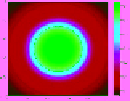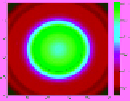Image Processing Reference
In-Depth Information
table 11.2
Family of Reconstructed Images for a Circle with a
Radius of 1λ for Varying Permittivity Values and Varying
Number of Randomly Spaced
Data Points in
k
-Space
ε
r
=
1.1;
N
=
3.3
ε
r
=
1.5;
N
=
3.8
ε
r
=
1.9;
N
=
4.3
NN/2
8
8
15
NN
16
16
30
2NN
32
32
48
4NN
72
72
108
12,960
12,960
12,960
Next, we look at the results from the square targets shown in Table 11.3. It
again is clear that, for the cases of
N
2
/2 and
N
2
total data points, the degrees
of freedom are clearly not satisfied for any of the permittivity cases. Likewise,
as before, the images are starting to take shape for the 2
N
2
case for all permit-
tivity values, but still appear as if they have not quite satisfied the overall
number of degrees of freedom. Finally, again as before, once the number of
data points reaches the 4
N
2
case it is evident for all permittivity ranges that
the image is fairly well formed. This even strengthens the idea that there is
an overall degrees of freedom criterion and that this limit is in the neighbor-
hood of 4
N
2
. This needs more exhaustive testing before it can be declared as a
theorem, but it surely presents a strong case for the relationships suggested for
overall degrees of freedom for imaging while using these techniques.
11.3 ConCluSIon
The problem of imaging from scattered fields is at least 100 years old and con-
tinues to provide challenges, both theoretical and experimental, across liter-
ally a broad spectrum of probing waves. The interaction of waves with matter,
be they acoustic or electromagnetic, is complex; even the direct problem, that

















Search WWH ::

Custom Search